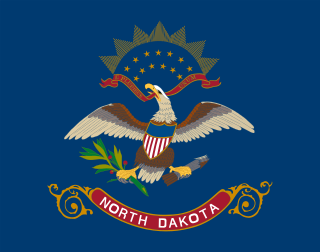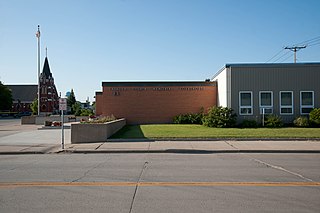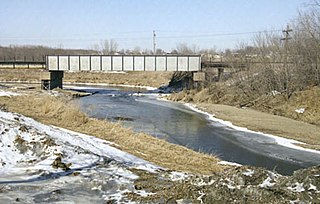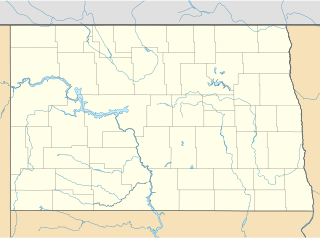
The Tongue River is a 90.4-mile-long (145.5 km) [1] tributary of the Pembina River in northeastern North Dakota in the United States. It drains an area of the prairie country near the Canada–US border in the extreme northeast corner of the state in the watershed of the Red River.

North Dakota is a U.S. state in the midwestern and northern regions of the United States. It is the nineteenth largest in area, the fourth smallest by population, and the fourth most sparsely populated of the 50 states. North Dakota was admitted to the Union on November 2, 1889, along with its neighboring state, South Dakota. Its capital is Bismarck, and its largest city is Fargo.

The United States of America (USA), commonly known as the United States or America, is a country composed of 50 states, a federal district, five major self-governing territories, and various possessions. At 3.8 million square miles, the United States is the world's third or fourth largest country by total area and is slightly smaller than the entire continent of Europe's 3.9 million square miles. With a population of over 327 million people, the U.S. is the third most populous country. The capital is Washington, D.C., and the largest city by population is New York City. Forty-eight states and the capital's federal district are contiguous in North America between Canada and Mexico. The State of Alaska is in the northwest corner of North America, bordered by Canada to the east and across the Bering Strait from Russia to the west. The State of Hawaii is an archipelago in the mid-Pacific Ocean. The U.S. territories are scattered about the Pacific Ocean and the Caribbean Sea, stretching across nine official time zones. The extremely diverse geography, climate, and wildlife of the United States make it one of the world's 17 megadiverse countries.

Prairies are ecosystems considered part of the temperate grasslands, savannas, and shrublands biome by ecologists, based on similar temperate climates, moderate rainfall, and a composition of grasses, herbs, and shrubs, rather than trees, as the dominant vegetation type. Temperate grassland regions include the Pampas of Argentina, Brazil and Uruguay, and the steppe of Ukraine, Russia and Kazakhstan. Lands typically referred to as "prairie" tend to be in North America. The term encompasses the area referred to as the Interior Lowlands of Canada, the United States, and Mexico, which includes all of the Great Plains as well as the wetter, hillier land to the east.
Contents
It rises in eastern Cavalier County and flows in a direct course east-northeast into Pembina County, passing the towns of Cavalier, Neche and Bathgate. It joins the Pembina from the south approximately 2 miles (3 km) upstream from the mouth of the Pembina on the Red River.

Cavalier County is a county in the U.S. state of North Dakota. It is south of the Canada–US border with Manitoba. As of the 2010 United States Census, the population was 3,993. Its county seat is Langdon. The city of Cavalier is in nearby Pembina County.

Pembina County is a county in the U.S. state of North Dakota. At the 2010 United States Census its population was 7,413. The county seat is Cavalier.

Cavalier is the largest city in Pembina County, North Dakota, United States. It is the county seat of Pembina County. The population was 1,302 at the 2010 census. Cavalier was founded in 1875 and became the county seat in 1911.
Upstream of Cavalier, the river passes through Icelandic State Park, where Renwick Dam causes it to form Lake Renwick. Below the dam, foot trails follow the river in the Gunlogson Arboretum Nature Preserve.

Icelandic State Park is a public recreation area located on Lake Renwick five miles (8.0 km) west of Cavalier in Akra Township, Pembina County, North Dakota. The state park's 912 acres (369 ha) include the Pioneer Heritage Center and the Gunlogson Homestead and Nature Preserve.

Renwick Dam is a dam in Akra Township, Pembina County, North Dakota, USA, in the northeastern corner of the state.











